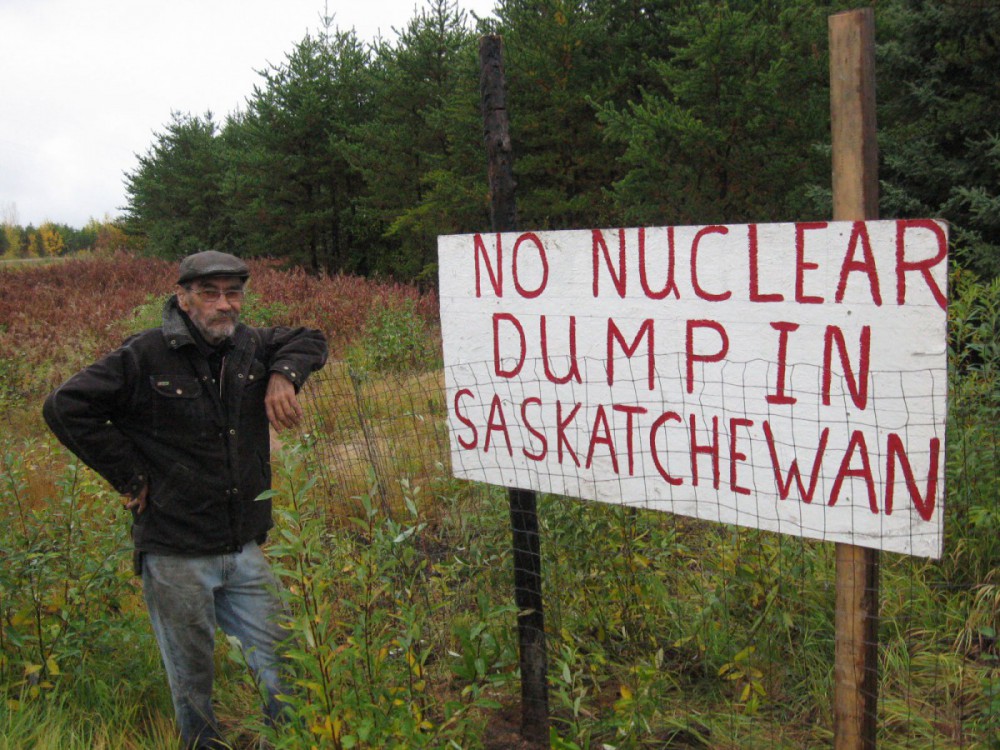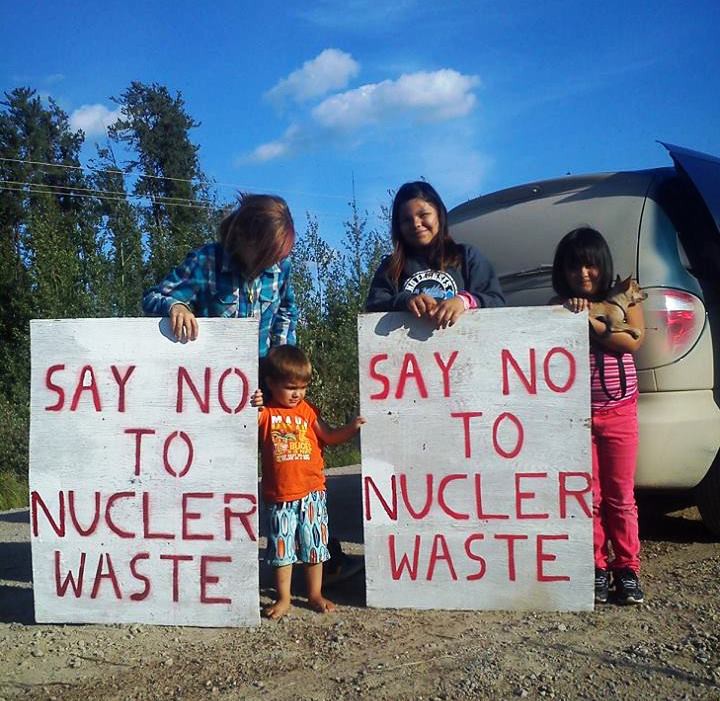
Early in March, Briarpatch magazine received documents from the Northern Village of Pinehouse, in partial compliance with one of two Freedom of Information requests filed a year ago. Pinehouse is an isolated village of just under 1,400 people, 80 per cent of whom are Cree speaking. The community is located about 500 kilometres north of Saskatoon.
The released documents primarily relate to the dealings of the Pinehouse leadership with the Nuclear Waste Management Organization (NWMO), a federally mandated consortium designated “to assume responsibility for the long-term management of Canada’s used nuclear fuel.” In recent years, NWMO has focused on finding a “willing host community” for a radioactive waste depository in more remote northern regions over the Canadian Shield rock formations, whose stability is viewed as more desirable for deep geologic waste storage.
As we’ll see, the correspondence between NWMO and the Village of Pinehouse in northern Saskatchewan sheds important light on the tactics NWMO uses when seeking hosts for Canada’s nuclear waste.
Between 2010 and 2013, NWMO pumped over $471,000 into Pinehouse coffers trying to convince residents that nuclear waste would be the answer to the community’s poverty and associated social problems. On August 12, 2010, the press announced that “Local leaders in Pinehouse are exploring the idea of hosting a nuclear waste storage site. Métis Nation–Saskatchewan area director Louis Gardiner was part of a delegation from the community that met with Nuclear Waste Management Organization officials in Toronto earlier this week.”
Five Pinehouse leaders had visited NWMO facilities in Ontario that month, at NWMO expense, to scope out the possibilities. Following discussions among NWMO, the Village, and Kineepik Métis Local Inc., a formal agreement was about to be signed. (Kineepik Métis Local Inc. is a private, non-profit corporation established in 2007, not a registered local of the Métis Nation–Saskatchewan, as its name seems to imply.)
Pinehouse mayor Mike Natomagan addressed the news report a few weeks later, confirming that NWMO was being invited to the village to discuss the idea. As MBC Network Radio reported, the mayor stressed that “the ‘Learn More’ opportunity does not commit the village or Métis local to any further steps.”
In fact, when Pinehouse leaders agreed to engage in NWMO’s “Learn More” program, they were committing to a major undertaking to promote NWMO’s agenda until at least June 30, 2011 (subsequently renewed several times more) with an initial outlay of $128,000 from NWMO.
On November 30, 2011 the Village and Kineepik Métis Local Inc. submitted a comprehensive approach to NWMO, in which Vince Natomagan, the mayor’s cousin and Kineepik Métis Local Inc.’s key proponent of the scheme, would “be the lead contact for Pinehouse as it relates to the NWMO initial screening and subsequent phases/events.”
Further, the document stressed, “It is also strongly suggested that Phillip Tinker be designated Elder for the [same] purposes … All inquiries from the community (and outside the community) will be directed to Vince Natomagan and Phillip Tinker.” Tinker was an admired community Elder, who recently passed away in 2013.
Unknown to most Pinehouse residents, the funds allocated to the Village by NWMO were largely dedicated to salaries for Vince Natomagan, Phillip Tinker, and Glen McCallum (a local Métis Nation leader). A budget for 2011 submitted to NWMO in February indicates that Vince Natomagan was receiving a monthly salary of $5,441, Tinker $3,001, and McCallum $2,601, paid from a NWMO fund set up within the Village accounts.
“The fox in the hen house”
Having the target community engage in a “Community Sustainability Visioning” process is integral to NWMO’s “Learn More” program. A community “Vision Statement” drafted in December 2010 by Vince Natomagan is difficult to reconcile with the role of NWMO, which is nowhere mentioned in it:
“Pinehouse will grow and prosper as a healthy, self-determined, self-sustaining northern community that is united and takes pride in our Aboriginal culture and traditions through sharing and caring. We are reclaiming our community through a holistic approach and promoting identity, culture, values, and beliefs.”
NWMO, Vince Natomagan, and their fellow planners required a clandestine approach. Already, suspicions had been growing in the community about what was afoot. On November 10, Vince Natomagan wrote to NWMO president Kenneth Nash: “We have taken the lead in northern Saskatchewan by opening the door for the NWMO; and we have taken some ‘hits’ from some tree hugger mentalities within our own community, our region and in the province (by virtue of blogs and media attention). They dare label us as ‘economic blackmail’ but we view it differently.”
The next step taken by NWMO’s Pinehouse contingent was to plan an ambitious “Northern Saskatchewan Elders Gathering” in June 2011 as part of the Community Sustainability Visioning process. It was anticipated that about 700 people from Pinehouse and other northern communities would attend. Besides demonstrations of traditional spirituality and lifestyles, there would be corporate information booths set up so that Indigenous youth could learn about job opportunities in industrial sectors like nuclear and uranium.
Included among the exhibits of future employers would, of course, be Nuclear Waste Management Organization. The total budget proposed for the Elders Gathering was $347,000, of which the local leaders suggested NWMO contribute $232,000. NWMO gave the matter due consideration and offered a more modest $40,000.
As the event date approached, a serious disagreement arose when NWMO’s Aboriginal Relations director Pat Patton wrote to mayor Mike Natomagan on May 24, 2011. “We will discuss with you the [nuclear waste repository] project in light of the community’s vision which has now been completed and submitted to NWMO on May 11th.” Patton also asked if a meeting could be set up at the Elders Gathering with the Métis Nation–Saskatchewan regional director, who had “indicated an interest in understanding in more detail how the APM [Adaptive Phase Management] site selection process [would] evolve.”
Immediately recognizing the inherent political pitfalls, Vince Natomagan responded on behalf of the Village and Kineepik Métis Local Inc.: “I will not be setting up this meeting due to the fact that I am co-ordinating the Gathering. (The ‘tree-huggers’ are just waiting for me to make a perceived ‘mistake’ to which I will not do).”
The email continues: “You asked if ‘the APM project aligns with the community vision.’ How in the world can the leadership of Pinehouse assume if the NWMO project is ‘in-line’ with the vision when we’ve strictly and clearly told the apprehensive community members that ‘the visioning process has nothing to do with the NWMO project? That’s like telling the fox in the hen house to ‘not engage’ the chickens!”

Apparently, the Pinehouse leaders did not want the public to know the direct relation between NWMO and the visioning process, or indeed that the Community Sustainability Visioning process had in fact already been completed and submitted to NWMO on May 11. The input received at the Elders Gathering would be irrelevant to the entire process.
Nevertheless, “the fox in the hen house” was in the process of being exposed. Early in May the Pinehouse leadership had hosted a healing circle at Muskwa Lake to discuss youth substance abuse and suicide. According to a Media Co-op report by journalist Sandra Cuffe:
“Halfway through the talking circle, one of the facilitators wrote ‘NWMO’ on the chart and ‘Duty To Consult’ right under it. And this was shortly after Vince Natomagan had joined the talking circle. He had come in with a briefcase and with some paperwork that he spread out on the table,” said [Max] Morin. “The red flags went up right away.”
“Ten elders from Pinehouse left immediately, he said. Others walked out soon after learning what NWMO stood for and that the local facilitators were advocating for a nuclear waste repository in the area.”
Elders and other leaders from northwest Saskatchewan now realized that direct action was required. Within days the Committee for Future Generations was formed and the 7000 Generations Walk Against Nuclear Waste from Pinehouse to the Saskatchewan Legislature in Regina was organized for that summer. From that point onward, every move that NWMO and the Pinehouse leaders made was closely scrutinized. In a March 2012 email to NWMO, mayor Mike Natomagan recalled that “Virtually all other local & regional initiatives we undertook were looked at as suspect.”
But the money kept flowing from NWMO to Pinehouse Village and Kineepik: $216,322 in 2011 and $216,132 in 2012. A financial statement submitted to NWMO in June 2012 indicates that Vince Natomagan was still getting a bi-weekly salary of $2,538 and Métis Nation leader Glen McCallum, $1,484. NWMO continued to disseminate one-sided information on the benefits of the project, and any contrary voices to the proposal were strongly discouraged.
When in November 2011 one Pinehouse resident suggested that a more independent source of information be brought to the community to speak, NWMO and the Village council declined the two names put forward. Ultimately, Dr. Gordon Edwards, a respected authority on the dangers of nuclear waste, came to Pinehouse and his expenses were paid privately.

“It will backfire big time”
Early in 2013 the relationship between NWMO and the Pinehouse leadership was beginning to fray. As the various stages in NWMO’s Adaptive Phase Management process moved along, community resistance continued to mount. NWMO tried to garner more support throughout the region. (English River First Nation, 100 km away, was also being considered as a nuclear waste site.) A NWMO initiative to fund “Learn More” opportunities in a handful of other communities brought a strong reaction from Vince Natomagan:
“About 3 weeks ago, your colleague Pat Patton introduced a new ‘program’ for $60,000 for each northern region of the Métis Nation–Saskatchewan. What is this ‘pool of money’ supposed to do? The NWMO is throwing a penny to a million dollar problem, and it will backfire big time. As Executive Director of Kineepik Métis Local Inc, I’m very much sensing that the board of directors of this vibrant Métis Local are not interested in this idiotic shortfall. It is rather quite a patronizing gesture from the NWMO … The NWMO needs to appreciate our internal and regional challenges. Selling your oil is tearing us apart.”
Documentation beyond May 2013 was outside the time frame in Briarpatch’s FOI requests, but we can report that by the end of 2013 NWMO had decided to discontinue its active consideration of Pinehouse as a potential radioactive waste site. While NWMO determined that Pinehouse (and nearby English River First Nation) did not meet the minimum conditions to continue in its screening process for the nuclear waste repository, as a golden handshake, NWMO agreed to “provide $400,000 to each community upon its establishment of a Community Well-Being Reserve Fund.”
One more Saskatchewan community, Creighton, is still under consideration for a nuclear waste site.
Deep divisions
For three years, from 2010 – 2013, The Nuclear Waste Management Organization vigorously promoted its agenda to locate a radioactive waste repository in the Pinehouse region. By pouring hundreds of thousands of dollars into that effort, NWMO and its paid local agents succeeded in sowing deep divisions among the local residents, who were torn between genuine, long-term environmental concerns and the promises of short-term, boom-town economic growth offered by the nuclear industry.
Briarpatch continues to demand a full response to its Freedom of Information requests, filed with the Village of Pinehouse in April 2013. In light of how the Pinehouse leadership has collaborated with NWMO, we are interested to learn more about the dealings of the Village and Kineepik Métis Local Inc. with the uranium companies Cameco and Areva, with whom a Collaboration Agreement was signed in December 2012.
At present, two legal claims have been filed in an effort to obtain full accountability and transparency from the Village. We will keep our readers informed as these cases move through the courts in coming months.



